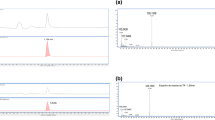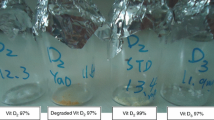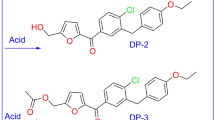Abstract
This work provides detailed mechanistic analysis of thermo-oxidative degradation behavior of vitamin D3—Ca (CaCO3 form) solid state supplement formulation. Analytical techniques such Attenuated Total Reflection Fourier-transform Infrared (ATR-FTIR) spectroscopy and Matrix-Assisted Laser Desorption/Ionization Mass Spectrometry (MALDI-MS) were used for analysis of homogeneity of active pharmaceutical ingredients (APIs) throughout excipients contained within solid dosage forms. Information gained from MALDI-MS experiments was used to improve and better understand interactions present, later clearly disclosed through kinetic modeling. It was found that process mechanism proceeds via two single-step unbranched reactions and two steps of consecutive reactions. Key features include vitamin D3 meltings and degradation via hydrogen abstraction followed by addition of oxygen forming 1-hydroxy-vitamin D3 and further through its dehydration to 1-keto-vitamin D3. Identified product 1-hydroxy-vitamin D3 is substantial for enhancing the immune response of human body in fight against respiratory viruses. Another two degradation products, namely pyrocalciferol and isopyrocalciferol, produced by thermal isomerization at higher temperatures, were also identified. These vitamin epimers have crucial role in functioning of immune cells. Degradation process of mineral structure occurs through water molecules removal, forming anhydrous polymorph of CaCO3, where formation of solid (CaO) and gaseous (CO2) products participates in kinetically stabilized additive-functionalized amorphous CaCO3 crystallization. Confirmation of correctness of proposed degradation mechanism was verified by modulated dynamic (MD) predictions. Information obtained is valuable and suitable for safety evaluations of given supplement, but also could be applied for solid state forms, which are generally sensitive to oxidative conditions.







Similar content being viewed by others
Data availability
The datasets generated during and/or analyzed during the current study are available from the corresponding author on reasonable request.
Code availability
Not applicable.
References
Zhao R, Zhang W, Ma C, Zhao Y, Xiong R, Wang H, Chen W, Zheng SG. Immunomodulatory function of Vitamin D and its role in autoimmune thyroid disease. Front Immunol. 2021;12:574967. https://doi.org/10.3389/fimmu.2021.574967.
Luo Y, Wu W, Gu J, Zhang X, Dang J, Wang J, Zheng Y, Huang F, Yuan J, Xue Y, Fu Q, Kandalam U, Colello J, Zheng SG. Human gingival tissue-derived MSC suppress osteoclastogenesis and bone erosion via CD39-adenosine signal pathway in autoimmune arthritis. EBioMedicine. 2019;43:620–31. https://doi.org/10.1016/j.ebiom.2019.04.058.
Christakos S, Dhawan P, Verstuyf A, Verlinden L, Carmeliet G. Vitamin D: metabolism, molecular mechanism of action, and pleiotropic effects. Physiol Rev. 2016;96(1):365–408.
Pike JW, Christakos S. Biology and mechanisms of action of the vitamin D hormone. Endocrinol Metab Clin North Am. 2017;46(4):815–43.
Goltzman D. Functions of vitamin D in bone. Histochem Cell Biol. 2018;149(4):305–12.
Battault S, Whiting SJ, Peltier SL, Sadrin S, Gerber G, Maixent JM. Vitamin D metabolism, functions and needs: From science to health claims. Eur J Nutr. 2013;52(2):429–41.
Charoenngam N, Holick MF. Immunologic effects of vitamin D on human health and disease. Nutrients. 2020;12(7):2097. https://doi.org/10.3390/nu12072097.
Jones G, Kaufmann M. Diagnostic aspects of vitamin D: clinical utility of vitamin D metabolite profiling. JBMR Plus. 2021;5(12):e10581. https://doi.org/10.1002/jbm4.10581.
Lips P, Gielen E, van Schoor NM. Vitamin D supplements with or without calcium to prevent fractures. Bonekey Rep. 2014;3:512. https://doi.org/10.1038/bonekey.2014.7.
Lips P. Worldwide status of vitamin D nutrition. J Steroid Biochem Mol Biol. 2010;121(1–2):297–300. https://doi.org/10.1016/j.jsbmb.2010.02.021.
Valladao DMS, De Oliveira LCS, Netto JZ, Ionashiro M. Thermal decomposition of some diuretic agents. J Therm Anal. 1996;46(5):1291–9.
Dollimore D. A breath of fresh air. Thermochim Acta. 1999;340–341:19–29. https://doi.org/10.1016/S0040-6031(99)00250-6.
Menen D, El-Ries M, Alexender KS, Rigo A, Dollimere D. A thermal analysis study of the decomposition of hydrochlorthiazide. Instrum Sci Technol. 2002;30:329–40.
Ramos P. Application of thermal analysis to evaluate pharmaceutical preparations containing theophylline. Pharmaceuticals. 2022;15:1268. https://doi.org/10.3390/ph15101268.
Juhász M, Takahashi S, Kitahara Y, Fujii T. Thermal decomposition of pyridoxine: an evolved gas analysis-ion attachment mass spectrometry study. Rapid Commun Mass Spectrom. 2012;26:759–64. https://doi.org/10.1002/rcm.6161.
de Souza SPMC, de Morais FE, dos Santos EV, Martinez-Huitle CA, Fernandes NS. Determination of calcium content in tablets for treatment of osteoporosis using thermogravimetry (TG). J Therm Anal Calorim. 2013;111:1965–70. https://doi.org/10.1007/s10973-011-2119-z.
Urankar M, Reddy N, Ranka V. Formulation development and evaluation of cholecalciferol (vitamin D3) granules and tablets. J Chron Drug Del. 2015;6(1):11–6.
Jannasari N, Fathi M, Moshtaghian SJ, Abbaspourrad A. Microencapsulation of vitamin D using gelatin and cress seed mucilage: production, characterization and in vivo study. Int J Biol Macromol. 2019;129:972–9. https://doi.org/10.1016/j.ijbiomac.2019.02.096.
Rodriguez-Blanco JD, Shaw S, Benning LG. The kinetics and mechanisms of amorphous calcium carbonate (ACC) crystallization to calcite, via vaterite. Nanoscale. 2011;3:265–71. https://doi.org/10.1039/c0nr00589d.
Myszka B, Schüßler M, Hurle K, Demmert B, Detsch R, Boccaccini AR, Wolf SE. Phase-specific bioactivity and altered Ostwald ripening pathways of calcium carbonate polymorphs in simulated body fluid. RSC Adv. 2019;9:18232–44. https://doi.org/10.1039/C9RA01473J.
Li J, Wu Y. Lubricants in pharmaceutical solid dosage forms. Lubricants. 2014;2:21–43. https://doi.org/10.3390/lubricants2010021.
López-Pablos AL, Leyva-Porras CC, Silva-Cázares MB, Longoria-Rodríguez FE, Pérez-García SA, Vértiz-Hernández ÁA, Saavedra-Leos MZ. Preparation and characterization of high purity anhydrous β-lactose from α-lactose monohydrate at mild temperature. Int J Polym Sci. 2018;2018:10. https://doi.org/10.1155/2018/5069063.
Abdullah AHD, Chalimah S, Primadona I, Hanantyo MHG. Physical and chemical properties of corn, cassava, and potato starchs. IOP Conf Ser Earth Env Sci. 2018;160:012003. https://doi.org/10.1088/1755-1315/160/1/012003.
Mahmoodani F, Perera CO, Abernethy G, Fedrizzi B, Greenwood D, Chen H. Identification of vitamin D3 oxidation products using high-resolution and tandem mass spectrometry. J Am Soc Mass Spectrom. 2018;29(7):1442–55. https://doi.org/10.1007/s13361-018-1926-x.
Vurdelja BD, Dimitrijević SP, Dimitrijević SB, Kamberović ŽJ, Veličković SR. Characterization of the Ag43Cu37Zn20 alloy surface after potentiostatic polarization using LDI-TOF mass spectrometry. Corros Rev. 2017;35(6):473–81. https://doi.org/10.1515/corrrev-2017-0065.
Katz AK, Glusker JP, Beebe SA, Bock CW. Calcium ion coordination: A comparison with that of beryllium, magnesium, and zinc. J Am Chem Soc. 1996;118:5752–63. https://doi.org/10.1021/ja953943i.
Mercê ALR, Yano L, Khan M, Thanh XD, Bouet G. Complexing power of vitamin D3 toward various metals. Potentiometric studies of vitamin D3 complexes with Al3+, Cd2+, Gd3+, and Pb2+ ions in water-ethanol solution. J Solut Chem. 2003;32(12):1075–85. https://doi.org/10.1023/B:JOSL.0000023922.74448.52.
Gadais JF, Khan MA, Bouet GM, Thanh XD. Spectroscopic evidence for cobalt(II) complexes with 25-hydroxycholecalciferol and 1α,25-dihydroxycholecalciferol in aqueous solution. Trans Metal Chem. 1994;19:651–2. https://doi.org/10.1007/BF00980423.
Angelova S, Nikolova V, Dude T. Divalent metal ions binding to lactose: a DFT computational study. Bulg Chem Commun. 2018;50:130–4.
Srivastava A, Tripathi R, Verma S, Srivastava N, Rawat AKS, Deepak D. A novel method for quantification of lactose in mammalian milk through HPTLC and determination by a mass spectrometric technique. Anal Methods. 2014;6:7268–76. https://doi.org/10.1039/C4AY00625A.
Sagar BT, Sharma YP, Rawat SS, Nangude SL. Formulation development and evaluation of effervescent tablet of alendronate sodium with vitamin D3. J Drug Deliv Therap. 2013;3(5):65–74.
Mahmoodani F, Perera CO, Fedrizzi B, Abernethy G, Chen H. Degradation studies of cholecalciferol (vitamin D3) using HPLC-DAD UHPLC-MS/MS and chemical derivatization. Food Chem. 2017;219:373–81. https://doi.org/10.1016/j.foodchem.2016.09.146.
Wang Y. Fat-soluble vitamins in dietary supplements: optimization of extraction, simultaneous determination by HPLC and stability studies. A PhD dissertation presented to the Graduate School of Clemson University, All Dissertations, 2019.
Tavcar-Kalcher G, Vengušt A. Stability of vitamins in premix. Anim Feed Sci Technol. 2007;132(1):148–54. https://doi.org/10.1016/j.anifeedsci.2006.03.001.
Tsai S-Y, Lin H-Y, Hong W-P, Lin C-P. Evaluation of preliminary causes for vitamin D series degradation via DSC and HPLC analyses. J Therm Anal Calorim. 2017;130(3):1357–69. https://doi.org/10.1007/s10973-017-6209-4.
Kumar MT, Jana S. Assessment of physical, thermal and spectral properties of consciousness energy treated cholecalciferol. J Adv Nanotechnol. 2021;1(3):56–73. https://doi.org/10.14302/issn.2689-2855.jan-21-3745.
Pratiwi M, Ylitervo P, Pettersson A, Prakoso T, Soerawidjaja TH. Magnesium stearine production via direct reaction of palm stearine and magnesium hydroxide. IOP Conf Ser Mater Sci Eng. 2017;206:012026. https://doi.org/10.1088/1757-899X/206/1/012026.
Mejri W, Korchef A, Tlili M, Amor MB. Effects of temperature on precipitation kinetics and microstructure of calcium carbonate in the presence of magnesium and sulphate ions. Desal Water Treat. 2014;52:4863–70. https://doi.org/10.1080/19443994.2013.808813.
Chen T, Neville A, Yuan M. Influence of Mg2+ on CaCO3 formation—bulk precipitation and surface deposition. Chem Eng Sci. 2006;61(16):5318–27. https://doi.org/10.1016/j.ces.2006.04.007.
Karunadasa KSP, Manoratne CH, Pitawala HMTGA, Rajapakse RMG. Thermal decomposition of calcium carbonate (calcite polymorph) as examined by in-situ high-temperature X-ray powder diffraction. J Phys Chem Solids. 2019;134:21–8. https://doi.org/10.1016/j.jpcs.2019.05.023.
Amer AA, Samir E-H. Hydration kinetics and fire resistance of recycled low grade alumino-silicate refractory bricks waste-metakaolin composite cement pastes. Egypt J Chem. 2017;60(3):421–33. https://doi.org/10.21608/EJCHEM.2017.3479.
Zheng J, Huang J, Tao L, Li Z, Wang Q. A multifaceted kinetic model for the thermal decomposition of calcium carbonate. Crystals. 2020;10(9):849. https://doi.org/10.3390/cryst10090849.
Curetti N, Pastero L, Bernasconi D, Cotellucci A, Corazzari I, Archetti M, Pavese A. Thermal stability of calcium oxalates from CO2 sequestration for storage purposes: an in-situ HT-XRPD and TGA combined study. Minerals. 2022;12:53. https://doi.org/10.3390/min12010053.
Khan M, Sarwar A, Wahab M. Chemometric assessment of thermal oxidation of some edible oils. Effect of hot plate heating and microwave heating on physicochemical properties. J Therm Anal Calorim. 2010;102(1):369–74. https://doi.org/10.1007/s10973-010-0703-2.
Igarashi J, Ikeda M, Sunagawa M. Kinetics of thermal [1,7a]-sigmatropic shift of hexafluoro vitamin D3 and vitamin D3 derivatives. Evaluation of conformations of the A ring affected by 1-OH and 3-OH groups. Bioorg Med Chem Lett. 1996;6(13):1431–6. https://doi.org/10.1016/S0960-894X(96)00245-4.
Georgieva V, Vlaev L, Gyurova K. Non-isothermal degradation kinetics of CaCO3 from different origin. J Chem. 2013;2013:1–12. https://doi.org/10.1155/2013/872981.
Du H, Courrégelongue C, Xto J, Böhlen A, Steinacher M, Borca CN, Huthwelker T, Amstad E. Additives: their influence on the humidity- and pressure-induced crystallization of amorphous CaCO3. Chem Mater. 2020;32:4282–91. https://doi.org/10.1021/acs.chemmater.0c00975.
Morales-Gonzalez OM, Escribà-Gelonch M, Hessel V. Life cycle assessment of vitamin D3 synthesis: from batch to photo-high p. Int J Life Cycle Assess. 2019;24:2111–27. https://doi.org/10.1007/s11367-019-01634-6.
Miller BE, Norman AW. Vitamin D handbook of vitamins. In: Machlin LJ, editor. Nutritional, biochemical, and clinical aspects. New York: Marcel Dekker Inc; 1984. p. 45–97.
Saponaro F, Saba A, Zucchi R. An update on vitamin D metabolism. Int J Mol Sci. 2020;21:6573. https://doi.org/10.3390/ijms21186573.
Mahmoodani F, Perera CO, Abernethy G, Fedrizzi B, Greenwood D, Chen H. Identification of vitamin D3 oxidation products using high-resolution and tandem mass spectrometry. J Am Soc Mass Spectrom. 2018;29:1442–55. https://doi.org/10.1007/s13361-018-1926-x.
Bikle DD. Vitamin D metabolism, mechanism of action, and clinical applications. Chem Biol. 2014;21:319–29. https://doi.org/10.1002/9781118453926.ch29.
Nestola M, Thellmann A. Determination of vitamins D2 and D3 in selected food matrices by online high-performance liquid chromatography-gas chromatography-mass spectrometry (HPLC-GC-MS). Anal Bioanal Chem. 2015;407(1):297–308. https://doi.org/10.1007/s00216-014-8123-y.
Child P, Kuksis A. Critical role of ring structure in the differential uptake of cholesterol and plant sterols by membrane preparations in vitro. J Lipid Res. 1983;24(9):1196–209. https://doi.org/10.1016/S0022-2275(20)37903-7.
Plat J, Baumgartner S, Vanmierlo T, Lütjohann D, Calkins KL, Burrin DG, Guthrie G, Thijs C, Te Velde AA, Vreugdenhil ACE, Sverdlov R, Garssen J, Wouters K, Trautwein EA, Wolfs TG, van Gorp C, Mulder MT, Riksen NP, Groen AK, Mensink RP. Plant-based sterols and stanols in health & disease: “Consequences of human development in a plant-based environment?” Prog Lipid Res. 2019;74:87–102. https://doi.org/10.1016/j.plipres.2019.02.003.
Tian XQ, Chen TC, Matsuoka LY, Wortsman J, Holick MF. Kinetic and thermodynamic studies of the conversion of previtamin D3 to vitamin D3 in human skin. J Biol Chem. 1993;268(20):14888–92.
Meana-Pañeda R, Fernández-Ramos A. Tunneling and conformational flexibility play critical roles in the isomerization mechanism of vitamin D. J Am Chem Soc. 2012;134(1):346–54. https://doi.org/10.1021/ja2077075.
Zou Z, Wouter JEM, Matveeva G, Jensen ACS, Bertinetti L, Hood MA, Sun C, Gilbert PUPA, Polishchuk I, Pokroy B, Mahamid J, Politi Y, Weiner S, Werner P, Bette S, Dinnebier R, Kolb U, Zolotoyabko E, Fratzl P. A hydrated crystalline calcium carbonate phase: calcium carbonate hemihydrate. Science. 2019;363(6425):396–400. https://doi.org/10.1126/science.aav0210.
Rodriguez-Navarro C, Ruiz-Agudo E, Luque A, Rodriguez-Navarro AB, Ortega-Huertas M. Thermal decomposition of calcite: mechanisms of formation and textural evolution of CaO nanocrystals. Am Mineral. 2009;94:578–93. https://doi.org/10.2138/am.2009.3021.
Ihli J, Kim Y-Y, Noel EH, Meldrum FC. The effect of additives on amorphous calcium carbonate (ACC): Janus behavior in solution and the solid state. Adv Funct Mater. 2013;23(12):1575–85. https://doi.org/10.1002/adfm.201201805.
Xu X-R, Cai A-H, Liu R, Pan H-H, Tang R-K, Cho K. The roles of water and polyelectrolytes in the phase transformation of amorphous calcium carbonate. J Cryst Growth. 2008;310(16):3779–87. https://doi.org/10.1016/j.jcrysgro.2008.05.034.
Cantaert B, Verch A, Kim Y-Y, Ludwig H, Paunov VN, Kröger R, Meldrum FC. Formation and structure of calcium carbonate thin films and nanofibers precipitated in the presence of poly (allylamine hydrochloride) and magnesium ions. Chem Mater. 2013;25:4994–5003.
Tone T, Koga N. Thermally induced aragonite-calcite transformation in freshwater pearl: A mutual relation with the thermal dehydration of included water. ACS Omega. 2021;6:13904–14. https://doi.org/10.1021/acsomega.1c01683.
Funding
Authors would like to acknowledge financial support of Ministry of Education, Science and Technological Development of the Republic of Serbia, under Contract numbers 451–03-9/2022–14/200105 (N. Manić) and 451–03-68/2022–14/200017 (B. Janković). Authors express special gratitude to dr Snežana Popović from Faculty of Sciences (University of Novi Sad, Serbia) for the help in TA measurements and useful instructions. Also, authors would like to thank the regular member of the Serbian Academy of Sciences and Arts (SANU), dr Slavko Mentus, for useful suggestions and comments regarding this paper.
Author information
Authors and Affiliations
Contributions
DJ was contributed to conceptualization, validation, investigation, resources, writing—review and editing, supervision. MĐ was contributed to validation, investigation, resources, visualization, supervision. AM was contributed to validation, investigation, visualization, supervision. NM was contributed to validation, investigation, visualization, supervision. SV was contributed to validation, investigation, visualization, resources, writing—review and editing, supervision. FV was contributed to validation, investigation, visualization, resources, supervision. BJ was contributed to conceptualization, methodology, software, validation, formal analysis, resources, data curation, writing—original draft, writing—review and editing, visualization, supervision, project administration.
Corresponding author
Ethics declarations
Conflict of interest
The authors declare that they have no known competing financial interests or personal relationships that could have appeared to influence the work reported in this paper.
Human or animal rights
This research does not involve Human Participants and/or Animals.
Additional information
Publisher's Note
Springer Nature remains neutral with regard to jurisdictional claims in published maps and institutional affiliations.
Supplementary Information
Below is the link to the electronic supplementary material.
Rights and permissions
Springer Nature or its licensor (e.g. a society or other partner) holds exclusive rights to this article under a publishing agreement with the author(s) or other rightsholder(s); author self-archiving of the accepted manuscript version of this article is solely governed by the terms of such publishing agreement and applicable law.
About this article
Cite this article
Jelić, D., Đermanović, M., Marković, A. et al. Novel insight in thermo-oxidative kinetics of vitamin D-based supplement formulation using TG–DTG–DTA, ATR-FTIR and MALDI-MS techniques. J Therm Anal Calorim 148, 4281–4305 (2023). https://doi.org/10.1007/s10973-023-12017-3
Received:
Accepted:
Published:
Issue Date:
DOI: https://doi.org/10.1007/s10973-023-12017-3




